
Train 1
Service: 2B44 0735 Sheffield to Huddersfield
Operator: Northern
Class: 150 (150106)
My journey
Whole route
Stats: 36.5 miles, 16 stops in 1:14 (29.5 mph)
At the Ibis, breakfast – full English – is included, so laden with calories I walked to Sheffield station. I hadn’t been on the tram-train, but there was always later. My first train would be along the Penistone Line. I’d only recently noticed that it even existed. It’s mostly single track and only has a service of one train per hour most of the time. It looked quirky and unusual, so of course I had to ride it.
I’d expected this to be my first ride this week on a Pacer, but it wasn’t to be. It was one of Northern Trains class 150s. The leg room on these is poor. I remember travelling on an Anglia Railways class 150 in about 2004 between Cambridge and Ipswich. It was the most uncomfortable train I’d ever been on. Today’s example doesn’t seem to plumb those depths, but I have travelled on better trains. Class 150s are the most basic of the Sprinter trains. Other members of the family include Dogboxes and the Class 158, a superior and faster version that I had sampled yesterday.
But the visibility from the windows was good and it was an interesting ride. We set off to Meadowhall, passing the sites of the closed Attercliffe Road and Brightside stations, which still existed when this was my stamping ground. At Meadowhall Interchange we branched off towards Barnsley, via Wombwell, one of those places I’ve long known existed without having a clue why I know about it.
The train was fairly busy with workers getting on and off at places such as Chapeltown, Elsecar and Barnsley itself. After Barnsley the main, double-tracked, line continues towards Wakefield, but we branched off to the left. This is a delightful single-track line, with long, sweeping curves through open countryside, small stations and very impressive examples of railway engineering. It’s sometimes the case that the worst view of a viaduct is when you’re right on top of it, but they’re often curved, so can still be enjoyed. But even if you’re unable to see the side of the structure you can still enjoy the view down into valley, and you can search for the viaduct on the Internet to discover what an amazing thing you’re passing over. Probably the cream of the crop was the Penistone viaduct – look it up.
We arrived ‘into’ Huddersfield. Or maybe we didn’t. I think that this particular railway idiom, or solecism, is rarer that it was. The inescapable mantra today is “see it, say it, sort it”, or some variation. I must have heard it several hundred times this week.
Train 2
Service: 2W04 1018 Huddersfield to Leeds
Operator: Northern
Class: 153
My journey
Whole route
Stats: 28.2 miles, 7 stops in 1:00 (28.2 mph)
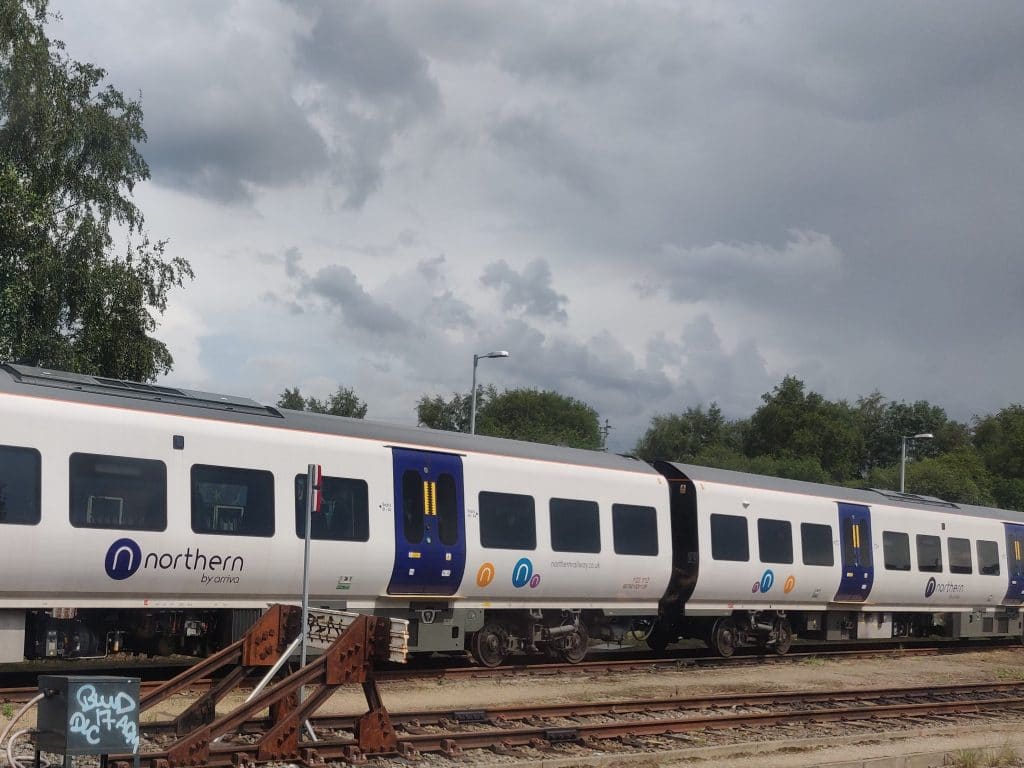
Once again, I lost my dignity. My train from Sheffield had arrived at Huddersfield one minute early. There was a train leaving in three minutes. I’d easily catch that, wouldn’t I? . But it proved to be quite a long way, along the platform and through a subway. I boarded the train, puffing and panting, expecting the doors to close behind me. I’d almost recovered by the time they actually did close after an unexplained five-minute delay.
There are fast trains between Huddersfield and Leeds, my next waypoint, but if I caught one of those I’d be retracing my steps of Monday. I had to go a different way, and I was not in a rush to get to my destination. The train I’d boarded did go to Leeds, but a long way round, via Bradford. And it took an hour. The direct train takes 19 minutes.
The train set off towards Leeds, but shortly arrived at a junction. Had it turned right, towards Mirfield, it would have reached Leeds fairly quickly, but it turned left instead, to Brighouse, a town I always associate with its brass band. After Brighouse we reached another junction (Greetland) and turned north, to Halifax, then on to Bradford Interchange, one of the two Bradford termini. We then reversed direction, branching off almost immediately to New Pudsey and Leeds.
This train was a Pacer, and the journey showed what’s good and what’s bad about them. The good: on a day like today the wide windows and low seat backs make them almost like a panorama car. You can see out of both sides, and the scenery was worth seeing. Also with opening windows you can hear everything: the sounds as your train passes over points and joints, and the notes of various pitches as bridges and tunnels reflect noises from the train. The bad: they look their age, and do not give the impression of anything except what they are; cheap trains that should have been withdrawn years ago. And the open windows have a downside whenever the train’s four-wheel truck tries to negotiate a curve with a deafening screech . There are those who become irate if you tell them that a Pacer is just a bus on a goods wagon chassis. Well, to my eyes the inside of a class 142 Pacer looks far more like an old and somewhat spartan bus than a train.
But that’s all changing. When I boarded this Pacer at Huddersfield there was a brand new class 195 at the station. We’re now part-way through a massive investment programme. Northern is getting a large fleet of new diesel and electric trains, and they’ve already started to enter service. TransPennine Express, whose trains are fine in themselves but too few in number, are also embarking on a mass upgrade. So are Transport for Wales. ScotRail already has many of its new trains running, especially on its newly-electrified and recently reopened lines.
Even in the Southeast, where trains are generally in better shape, the large Great Northern, Thameslink and Southern franchise (well, management contract) has introduced 115 brand new trains on the Thameslink network. Half of these are eight cars long, the rest a generous 12. Greater Anglia has started running the first of its new trains. They are replacing their entire fleet, including the class 379 Stansted Express trains that entered service at the end of 2011.
South of the river, South West Trains (now South Western Railway) ordered 30 new 5-car trains to enable more services to be run. These started to enter service in August 2017. They are now no longer required – I’ll let that sink in – as other new trains have been ordered that will make them redundant. So their life doing the job they were bought for will be about two years, and as I write this no new use has been found for them.
What happens to hundreds of supplanted trains? Some will be ‘cascaded’ elsewhere. They replace older trains. The transfer often comes with a refurbishment that makes them decent trains again, far better than the things they’re replacing. But the rest? Who knows? Some of the first batch of Pacers were sold to Iran, presumably as punishment for their nuclear programme. Many trains, not all of them obsolete, will be scrapped, but the rolling stock leasing companies will be trying hard to find homes for the rest. Not only for financial reasons but because they’re running out of places to store the damn things.
I should be celebrating such massive investment, and I do, really. But cheap money has extraordinary side effects. It really does seem to be cheaper to order new trains than keep the ones you already have, even if they’re only ten years old (the Stansted class 379s) or just two years old (South Western Railway’s class 707). What a waste.
But I was sitting on a decrepit Pacer. As it squealed and bucked towards Leeds I checked Real Time Trains. My next train would leave from Platform 1. I know this platform as it’s used for the round-the-houses trains to York via Harrogate and Knaresborough. I had about 15 minutes to kill, so would go straight to the platform.
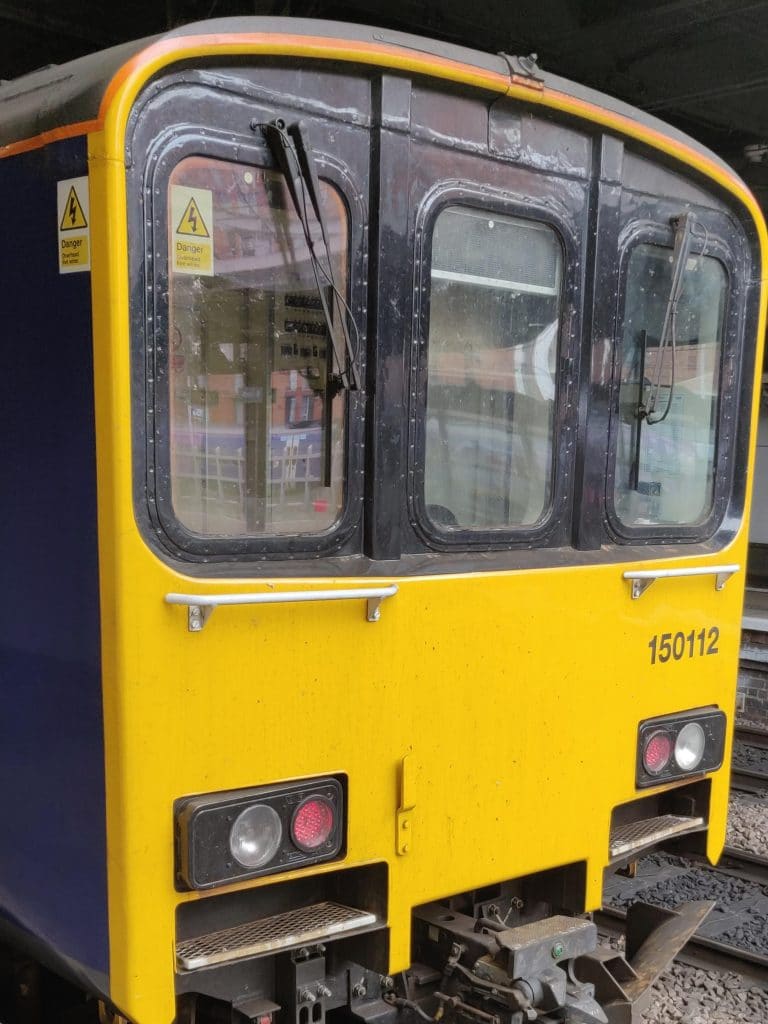
Train 3
Service: 2H06 1018 Leeds to Morecambe
Operator: Northern
Class: 150 (150112)
My journey
Leeds to Lancaster
Stats: 70.3 miles, 13 stops in 2:01 (34.9 mph)
Have I mentioned that I very rarely experience delays and cancellations on my trips? And that this trip seems different? I sat on Leeds platform 1 for many minutes. My train was on the display, but with no platform allocated. The estimated departure screen remained fixed at the booked 11:18 until after that time, when the train status changed to delayed.
Eventually, an update. It was to leave from platform 11. I trudged over the footbridge all the way to near enough the far side of the station. There were a few passengers there, but no sign of a train. There was, though, in a nearby platform, a very smart rake of maroon carriages with veteran class 57 diesel locos growling and smoking away at each end; clearly a charter train. I was envious of the comfortable seats I knew they’d be enjoying.
But then a train pulled into platform 11. The cab door opened to allow a pair of fitters to clamber from the platform into the train. This did not look good. The train was due out some time ago and only now are some men getting on board to resolve whatever has been ailing the thing. They wandered about, opening covers, staring at this that and, because they were fitters, thumping things from time to time. Then, after a particularly effective thump, they looked hopeful. Something was about to happen.
It started to look good on the platform, too. The hazard warning lights on the side of the train shone their amber shine. Most regular passengers know that the most common reason for these lights to come on is that the doors have been released. So, half of the platform walked to the train and pressed the door open buttons. All that happened was that the doors on the other side of the train opened. They closed again, then opened and closed a few more times before satisfying the fitters to the point that they jumped off, fetching the train a couple of sound clouts as preventative maintenance. The driver then opened our set of doors, and we took our seats.
There were no further delays and we were heading west about fourteen minutes after we were supposed to. The object of this journey was to travel on the line between Settle and Carnforth. I’ve ridden on the spectacular line to Carlisle, but the route to Carnforth is its little sister: almost as beautiful, a bit shorter, and with fewer admirers. Had I wanted to learn more about this route I could have looked it up. Luckily I didn’t need to, because a man in the seat behind me knew everything there is to know. He struck up conversation with the train manager. The latter didn’t have much to do as stops were infrequent, so Nigel, as I expect he was named, was able to give the hapless Northern Trains employee the full benefit of his very extensive knowledge.
The first thing I learned from Nigel was that the charter train I’d seen at Leeds was travelling up the line to Carlisle. Many charters go this way to experience the Pennines at their best. He also pointed out as we stopped at Skipton that the charter was in the loop on our left, presumably to let us, a scheduled service and not a plaything of rich Americans, overtake.
I know the first few miles of the line from Leeds fairly well from visiting my daughter when she was living up there. The line is far from boring almost from the outset, passing Kirkstall Abbey in the Leeds suburbs, Saltaire with its magnificent factories and cottages built by Titus Salt, and an impressive flight of locks on the Leeds and Liverpool Canal at Bingley. For those interested in railways we passed what I believe to be the only triangular station with platforms on all three sides, although as Nigel explained some of the platforms are quite recent. Trains wishing to call at Shipley, an important junction linking lines from Leeds and Bradford, used to have to stop beyond the station and then be propelled into the platform, reversing direction when it was time to leave.
Some time after Skipton we stopped at Hellifield where a large steam engine was waiting to be backed onto the charter when it arrived, to take it on to Carlisle. I can’t remember what engine it was but its name was redolent of Empire. Was it that splendid Gresley A4 The Union of South Africa, or Osprey as it used to be known? I really can’t remember. Probably not, as I seem to remember an Indian connection. Naturally, my source was Nigel.
There’s a trailing junction at Hellifield where we met a line from Blackburn. I must add that to my visit-another-day list.
After Settle we branched off the Carlisle line to forge our own path towards Carnforth. I learned from Nigel that he was a member of the friends of this line, the Bentham Line.
According to Community Rail Lancashire
The Bentham Line (Leeds to Lancaster & Morecambe) often referred to as the ‘Little North Western’ is a gem of a line but it is often eclipsed by its more well known neighbour the Settle Carlisle line. Crossing three rivers the Lune, Wenning and Ribble, the line is very picturesque with excellent views to the Dales, Ingleborough and towards the Forest of Bowland AONB.
And it is rather special. It is, like its big sister, traditionally signalled, although this is sparse. Nigel pointed out that it contains Britain’s longest signal block, at 23 miles. Trains can take 45 minutes to pass though it. A basic feature of traditional (and not so traditional) signalling is that only one train may be in a block at a time, so you don’t need to be a signalling and telecoms engineer to work out that the capacity of this line is limited.
As we travelled past hills and rivers Nigel explained the work of the the organisation he belongs to. I’m not sure which one – the community rail partnership, the friends of Bentham Station, or another, but they do sterling work, as do many such organisations around the rail system. They raise funds, maintain station buildings and gardens, publicise the line and perform other roles helping to keep the line’s subsidies within reason. Most are volunteers, of course. I forgive Nigel his excessive loquacity. If it’s due to pride in his organisation or love of the line then he’s earned the right to be a little over-enthusiastic.
Leaving the hills we reached Carnforth, passing over the West Coast Main line to access the platforms. Just before we reached it a steam engine passed on the other line, running light, or perhaps hauling a support coach. Off to join another charter? More likely just a test run from Carnforth.
Carnforth is, of course, where Brief Encounter was filmed. The station fell onto hard times after that, with the main lines being diverted to the east of the station, leaving Carnforth just an oversized local station on a pair of rural branch lines. But now the station’s been done up and the tea room restored to its condition in the film, but without the 1950s prices. More excellent work by mainly voluntary non-railway interests.
There’s still at least one semaphore signal at Carnforth, but we were to leave the Edwardian period behind as we moved onto the West Coast Main Line for the short hop to Lancaster. Leaving Carnforth we passed West Coast Railway’s extensive sidings. There was a short-lived museum here called Steamtown. I don’t know why it closed but I’d like to visit the site now. It must be the largest collection of preserved steam and diesel engines in the country, together with a large number of British Rail mark 1 and 2 carriages. West Coast Railway is the company that operates many of the country’s heritage and charter services. They’ve had run-ins with the regulators for astonishingly poor safety management, and were involved in what could have been a very serious incident in 2015 when one of their steam trains, with a deliberately disabled automatic warning system, ran past red signals through a junction that carries frequent trains running at 125 mph.
My train was supposed to continue to Morecambe, on the coast, but Nigel had predicted correctly that it would be cancelled beyond Lancaster so that it could depart back to Leeds on time. I was getting off at Lancaster in any case, and we’d arrived at a platform used by trains heading south. Had the train been continuing to Morecambe it would have quickly reversed. As it was it just sat there, blocking one of the main line platforms.
Train 4
Service: 1M11 1040 Glasgow Central to Euston
Operator: Virgin Trains
Class: 390 (390122)
My journey
Lancaster to Wigan Northwestern
Stats: 36.1 miles, 2 stops in 0:32 (67.7 mph)

Passengers who wanted to travel on towards Morecambe had to cross the footbridge for their train, but all I had to do was stay where I was and wait. However, there was, of course, a hitch. A signalling problem north of where I was. The wait proved short and I was able to jump on a smart red Virgin Trains Pendolino heading towards London. My journey was short, 36 miles to Wigan, which we reached in 32 minutes.
I needed to change both trains and stations at Wigan. The Pendolino dropped me at Wigan North-Western Station and my next train left from Wallgate. I didn’t know how far the walk would be but saw that there were clear directions at the exit from North Western. In fact Wallgate was about two minutes away, and a nice looking station it is. It has a large canopy supported by columns at the front, protecting those arriving by road at the station entrance. It looks as if it was added after the station was built, and is less impressive that the integral portes-cochere found at some stations, but it’s pleasing enough for Wigan.
That walk was only 200m in length but the stations are a world apart. North Western is a modern British main line station, with Pendolinos trains, red with Virgin bonhomie, tearing up and down the line and leaning into the bends as if on a TT race. Wallgate is very much a northern station, with slow, purple, Northern trains and clouds of pungent diesel exhaust.
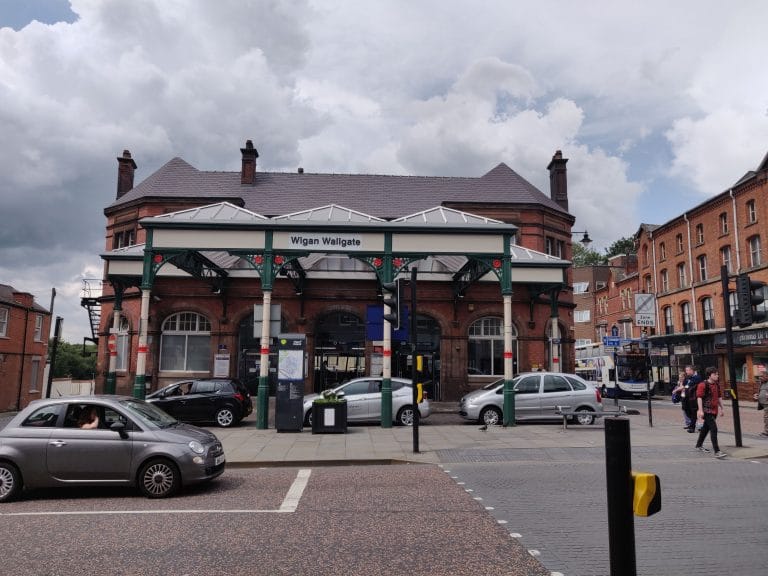
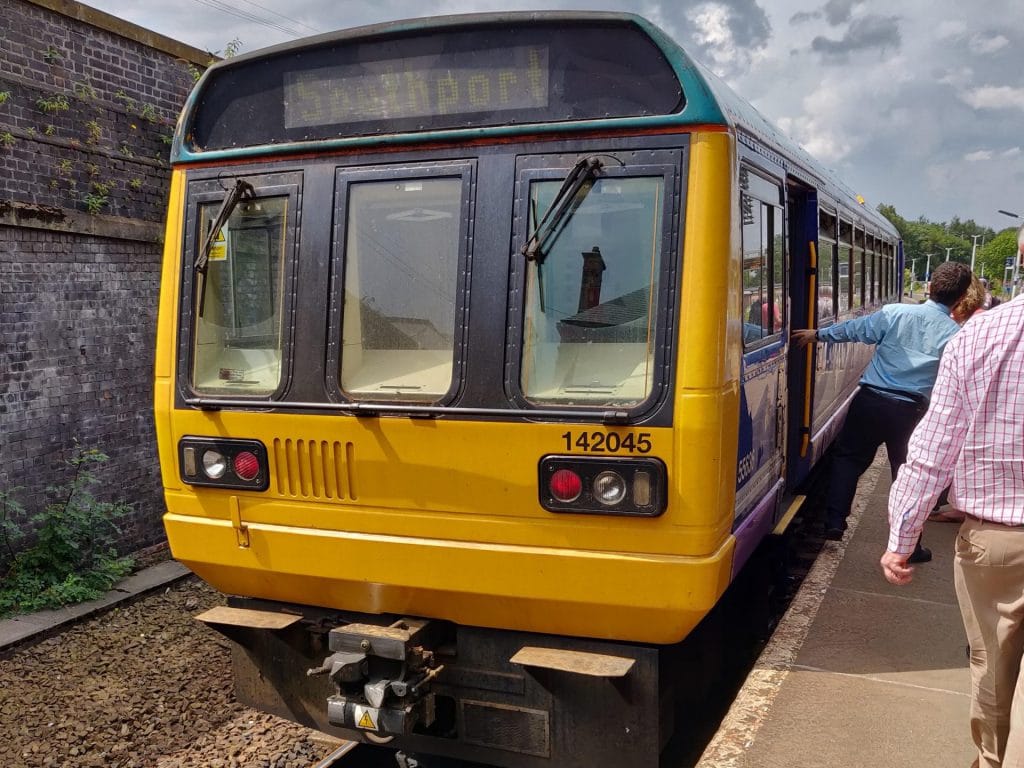
Train 5
Service: 1J13 1120 Manchester Victoria to Southport
Operator: Northern
Class: 142 (142045)
My journey
Wigan Wallgate to Southport
Stats: 17.4 miles, 6 stops in 0:32 (32.7 mph)
My train from Wigan was another Pacer. Is this to be the last I ever ride in? I hope not, in some ways. It carried a class 1 headcode so was classified for signalling purposes as an express passenger train. To paraphrase Arthur Dent, this is obviously a strange new meaning of the term express I’d previously been unaware of. This train was taking me to the seaside again, this time Southport. I was looking forward to it.
The journey was interesting enough, but the only thing that really caught my eye was a signal post not that long before our destination which had semaphore stop and distant arms, both showing an off aspect. As a boy this arrangement was very common, but I haven’t seen it for a very, very long time. The two signal arms are worked from different boxes. The stop signal is worked by the local box and tells the driver that it is safe to proceed into the block section towards the next signal box; the distant signal is worked by that box and tells the driver that all signals controlled by that box are clear, so he or she can give it some welly. For both signals to share a post the two signal boxes must be close together, and that suggests a busy line. Most busy lines have had their signalling brought into the latter half of the 20th century by now.
Southport is approached past various yards and sidings and is a large station, with six platforms. Three are used by train such as this, coming from the Wigan direction. The others are on the electrified MerseyRail network, which I planned to sample later. The track layout reminds me a little of Brighton. Both Brighton and Southport are terminal stations served by effectively separate lines. The platforms are arranged so that each platform is accessible from just one of those lines, so you have in effect two distinct stations side by side. Except for platform 3 in both cases, which can be used by trains on either line. Yes, I am aware that I’m simplifying Brighton slightly, but the comparison stands.
Southport itself is a splendid place. Between the station and sea front I passed a most magnificent war memorial and some elegant shops. Once at the front I saw the pier and learned that it’s second in length only to Southend. I set out to walk to the end. There’s a tram track running the length of the pier but it’s no longer in use, although a road train does carry passengers along the route. Had the tram still been running I would have had to try it out, but I wasn’t prepared to wait for a road train so walked the 1.1 km to the far end.
The pier is unusual in that it starts some way inland and passes over some pleasant gardens, with boating lakes and a miniature railway. Once over the sea proper there are excellent views, especially of mud, and a friendly lady selling hot drinks at the far end.
I haven’t mention the weather much. Apart from Saturday, when it was chucking it down, I’ve not had bad weather. There have been yellow warnings for rain all week, and there has been the odd bit of disruption caused by it, but I’ve avoided it all. But the skies to the south of that pier were black, and it was clear that Liverpool or thereabouts was getting a sound dousing. In case it headed my way I walked briskly back to the station.
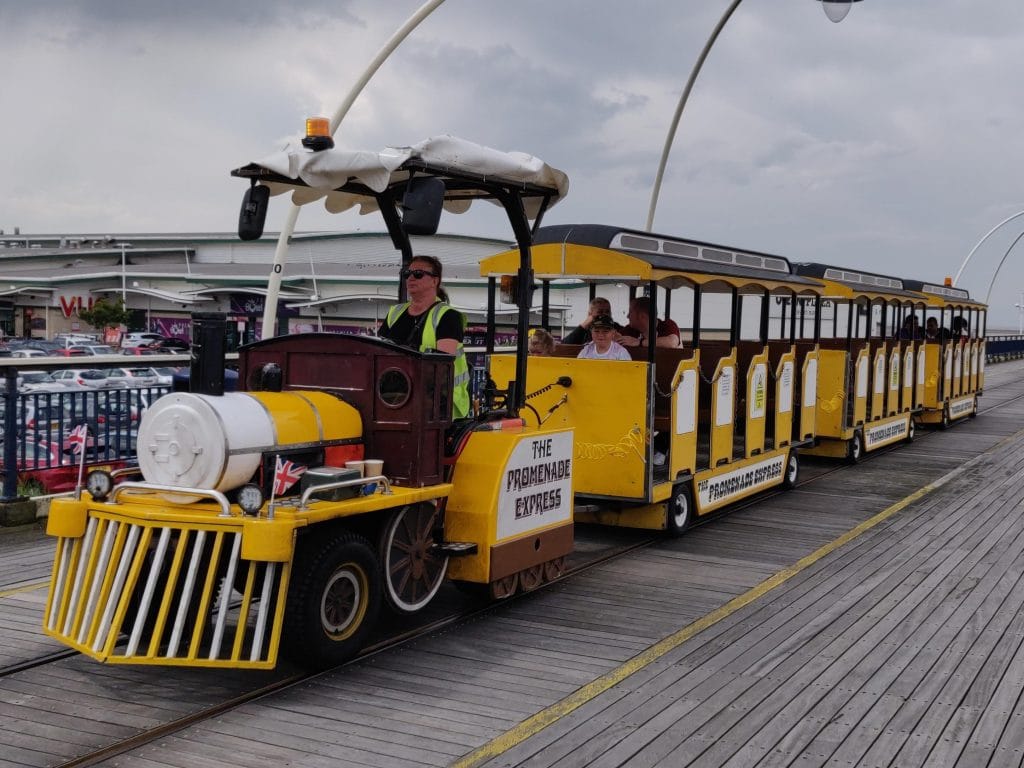
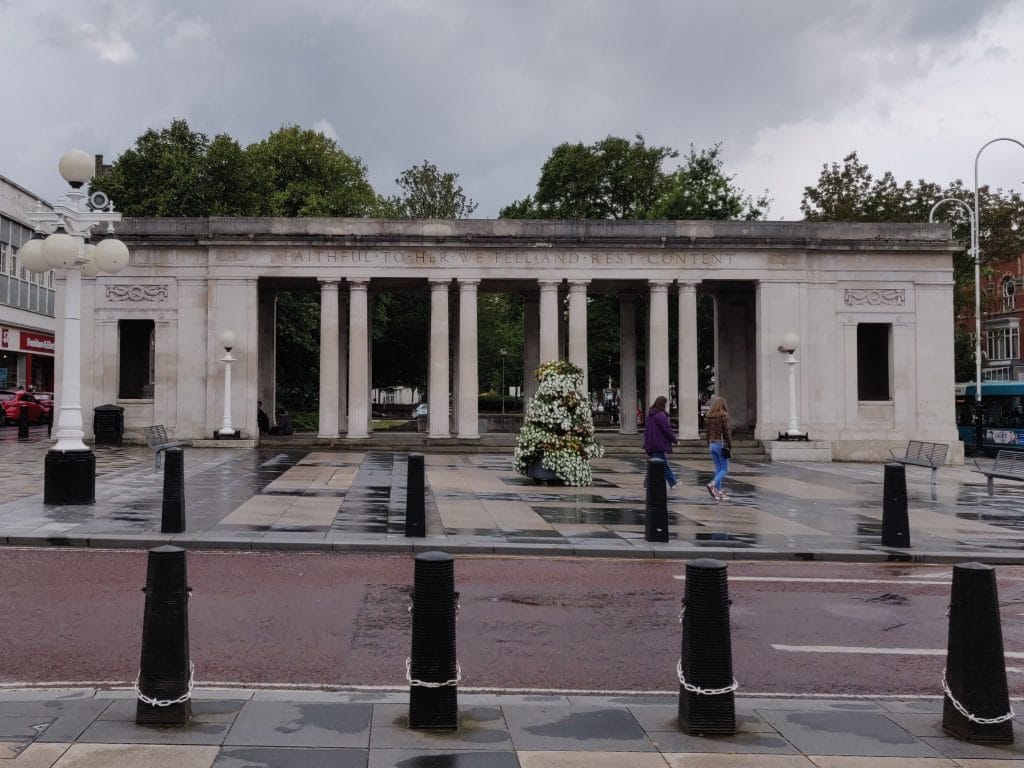
Train 6
Service: 2U38 1458 Southport to Hunts Cross
Operator: MerseyRail
Class: 507/508
My journey
Southport to Liverpool Central
Stats: 19.1 miles, 16 stops in 0:45 (25.5 mph)

Apart from a very short ride a couple of years ago when trying not to miss the Isle of Man ferry I had never used MerseyRail, and as it’s such a large network, and unusual in some ways (third rail electrification north of the Thames; a significant underground section) I thought I’d give it a go. Southport is on its Northern Line which hogs the coast, passing golf courses, dunes, nature reserves and small towns. It looks a nice part of the world.
There can be few stretches of railway with quite so many level crossings as this. There seemed to be one at every station and a few more besides. Strangely, the more urban parts of the line felt a little to me like the line out of Waterloo as it passes through Mortlake and Sheen. Talking of Waterloo, we called at a station called just that. Just think how confusing that could be.
All in all I enjoyed the ride. The train was a veteran, a class 507 or 508, so it could date back to 1978. It’s very similar to the class 313 trains that are being withdrawn from the Great Northern network but it seemed much, much better. The 313s are scruffy and dirty. Everybody knows that their time has come, and Great Northern has neglected them, leaving them with paint scoured off when graffiti has been removed and evidence of old liveries showing in places. MerseyRail show that just because a train is old it doesn’t have to be unpleasant.
I would have liked to see quite a bit of the MerseyRail network, especially the Wirral lines with the tunnel under the Mersey and the city loop, but time was getting on. I should head back to Sheffield and my bed. The Northern Line does not serve Lime Street but does stop at Liverpool Central, so that’s where I got off.
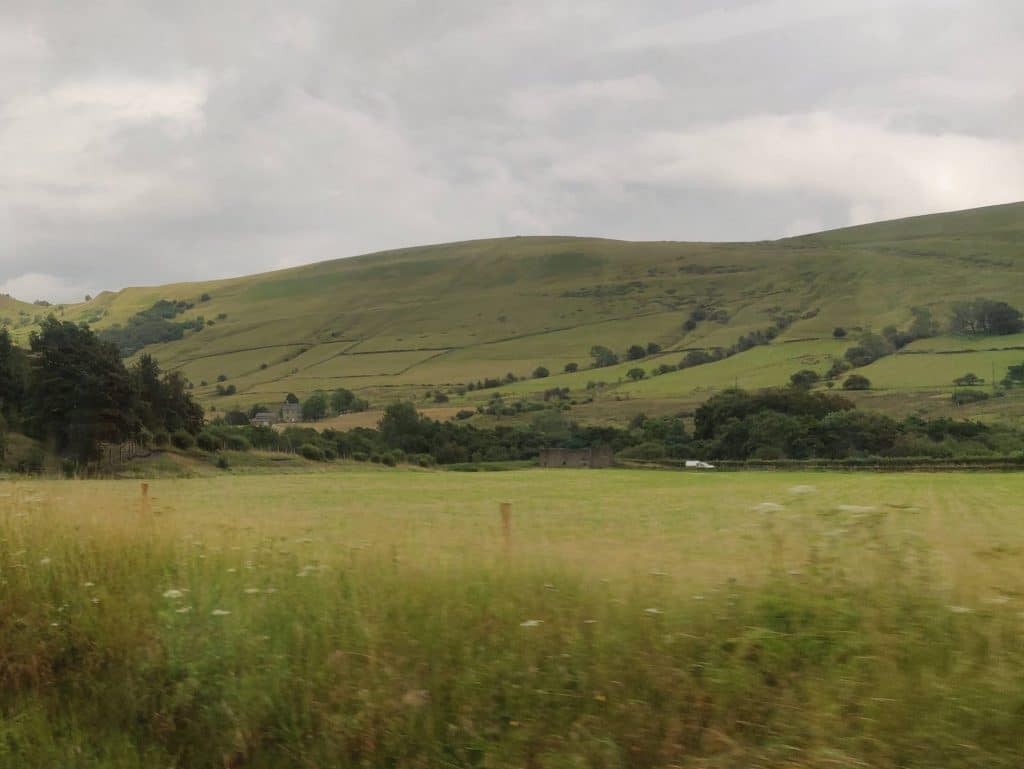
Train 7
Service: 1L14 1551 Liverpool Lime St to Norwich
Operator: East Midlands
Class: 158
My journey
Liverpool Lime Street to Sheffield
Stats: 77.4 miles, 9 stops in 1:55 (40.4 mph)
As I approached Liverpool Central I’d seen that there was a train due from Lime St. that I would almost certainly miss, and one 20 minutes later which not only called at Sheffield but was… cancelled. I had to run. Again. To the far side of the bloody station. And half way along the platform.
This train was operated by East Midlands Trains on the lengthy Liverpool Lime Street to Norwich service, a route that is set to be split into two in a future timetable. It was a smart, fairly comfortable but much too short class 158 Super Sprinter, with standard class seating only. We left on time and soon called at our first stop, Liverpool South Parkway. Change here for the Northern Line, it said. So I hadn’t needed to run from Liverpool Central after all, I could have stayed on the train and changed here. But then I’d have had to stand for a while. As it was I just sat back and watched the Peak District go by, taking a not very impressive 1:55 to cover the 77.4 miles.
So ended another very mixed but definitely enjoyable day on the railways.